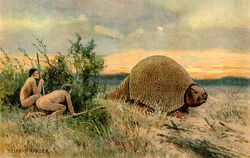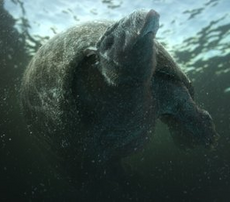
Painting of a glyptodont by Heinrich Harder.
Glyptodonts were prehistoric giant armadillos of the family Glyptodontinae, which lived in South, Central, and parts of North America from the early Miocene until at least 11,000 years ago. Although they are believed to have gone extinct at around the same time early humans arrived in South America, some cryptozoologists have suggested they may still survive.[1][2]
South America[]
Dale A. Drinnon suggests that the giant armadillo tatu-aruiap could be a living glyptodont.[3] Jorge Claraz, Francisco Moreno, and Austin Whittall all believe(d) that the Chilean ellengassen, a man-like animal with a large shell, may have been a late-surviving glyptodont.[4]

The minhocão depicted as a glyptodont by Philippe Coudray in Guide des Animaux Cachés (2009).
The theory that the minhocão could be a living glyptodont appears to have first been proposed by the editor of Müller's report published in Nature (1878),[5] and was later supported by Emil Budde,[2] and, originally, Bernard Heuvelmans.[6] In the English publication of Müller's report, after going over the lungfish theory, the editors cautiously suggested that, given that certain armadillos are subterranean, "may there not still exist a larger representative of the same or nearly allied genus, or, if the suggestion be not too bold, even a last descendant of the Glyptodonts?"[5]
Heuvelmans later supported this theory in On the Track of Unknown Animals (1955). Under the assumption that glyptodonts were burrowing animals, Heuvelmans noted that a glyptodont would, generally, provide a good physical match with the minhocão, with its bony armour and pig-like snout, and suggests that the moving "horns" reported of the minhocão were in fact pointed ears. If glyptodonts were burrowers, their tunnels would cause severe subsidence and damage, as in Africa, even relatively small aardvarks are known to cause roads to collapse with their burrowing. In addition, modern armadillos, though not aquatic, are known to be good swimmers, crossing streams by running across the bottom, and crossing wider rivers by inflating their intestines with air, allowing them the float across even in spite of their armour. Heuvelmans suggested that a glyptodont with these adaptations could have taken to the water in order to better support its heavy body.[6]
The glyptodont theory was heavily criticised by Karl Shuker, who notes that it seems unlikely that anyone would compare a tank-like glyptodont to a giant worm, writing that "anything less serpentine than a glyptodont would be hard to imagine". Moreover, he pointed out that it seems unlikely for glyptodonts to have been burrowing animals. Their vertebrae were fused, their front limbs, despite showing some fossorial characteristics, seem to have been largely inflexible, and Shuker questions why such a well-armoured animal would need to burrow in the first place. Most fossorial animals are devoid of body armour, which would only impede their burrowing without giving any benefit, since burrowing animals are unlikely to be attacked by predators. The defenses of glyptodonts, on the other, suggest that they frequently confronted predators. Shuker also argues against the possibility that glyptodonts could have been aquatic, given their very heavy armour, and points out that the scutes of glyptodonts did not actually resemble armadillo scales.[1]

A glyptodont depicted swimming underwater in the BBC's Ice Age Giants.
However, Dale A. Drinnon argues against Shuker's criticism, noting that the gopher tortoise (Gopherus polyphemus), despite also having a domed shell, is a burrowing animal.[3] Recent research has also suggested that glyptodonts, like the ground sloths, may indeed have been burrowing animals, perhaps to avoid the heat of the day, as they also appear to have had poor eyesight.[7][8][9] In addition, according to palaeontologists consulted for the BBC documentary Ice Age Giants, glyptodonts may have fed on aquatic plants and appear to have adaptations for an amphibious existence.[10]
In his 1986 checklist, Heuvelmans wrote that the minhocão could be a species of amphibious burrowing mammal,[11] but did not directly identify it with a glyptodont, and by the publication of his updated checklist, he instead suggested that it was a fossorial amphibian: as noted by Karl Shuker, he had moved away from the glyptodont theory to support Shuker's caecilian theory.[12]
Given the objections to the glyptodont theory, a similar but alternative theory regarding the minhocão is that it may be a living pampathere. These giant armadillos resembled glyptodonts, and also had pig-like snouts, but were somewhat more elongate, and had banded plates - which, as Shuker notes, did resemble the scales of armadillos[1] - on their midsections, allowing them some degree of flexibility, so they may have borne more resemblance to the minhocão than a glyptodont.[2] Pampatheres are also now regarded as burrowing animals.[8]
Heuvelmans also theorised that sightings of these hypothetical amphibious glyptodonts could explain certain sucuriju gigante and giant anaconda accounts, if only the top of the glyptodont's head and "scaly" carapace were seen above the water.[6]
Known hoaxes[]
On 7 October 1967, Science News reported that an "giant armadillo" which had been believed extinct, 6'6'' long and 2,200lb heavy, had been captured in Argentina. Given the armadillo's size and the fact that the giant armadillo (Priodontes giganteus) is not known from Argentina, Michael J. Shields speculated that it might have been a surviving glyptodont, leading Ivan T. Sanderson to investigate the matter through the Society for the Investigation of the Unexplained. However, Sanderson discovered that the story was a "ninth-hand" tale originating from an unknown source in Mexico's Argentine embassy.[1]
See also[]
Notes and references[]
- ↑ 1.0 1.1 1.2 1.3 Shuker, Karl P. N. (1995) In Search of Prehistoric Survivors: Do Giant 'Extinct' Creatures Still Exist?, Blandford, ISBN 9780713-724691
- ↑ 2.0 2.1 2.2 Eberhart, George M. (2002) Mysterious Creatures: A Guide to Cryptozoology, ABC-CLIO, Inc., ISBN 1576072835
- ↑ 3.0 3.1 Drinnon, Dale A. (2009) "Amended Cryptozoological Checklist"
- ↑ Whittall, Austin Mapinguari the Amazonian Mylodon | Patagonian Monsters patagoniamonsters.blogspot.com [Accessed 7 February 2019]
- ↑ 5.0 5.1 "A New Underground Monster," Nature 17 (1878)
- ↑ 6.0 6.1 6.2 Heuvelmans, Bernard (1955) On the Track of Unknown Animals, Routledge, ISBN 978-1138977525
- ↑ Vizcaino, S. F. & Bender, R. E. & Milne, N. "Proportions and function of the limbs of glyptodonts," Lethaia 44 (2011)
- ↑ 8.0 8.1 Emerling, Christopher A. & Springer, Mark S. "Genomic evidence for rod monochromacy in sloths and armadillos suggests early subterranean history for Xenarthra," Proceedings of the Royal Society of London B: Biological Sciences 282 (2015)
- ↑ Zacharias, James Discovering the Glyptodont moas.org [Accessed 6 June 2019]
- ↑ "Land of the Sabre-tooth". Ice Age Giants: Series 1, Episode 1
- ↑ Heuvelmans, Bernard "Annotated Checklist of Apparently Unknown Animals With Which Cryptozoology Is Concerned", Cryptozoology, No. 5 (1986)
- ↑ Shuker, Karl P. N. "A Supplement to Dr Bernard Heuvelmans' Checklist of Cryptozoological Animals," Fortean Studies, Vol. 5 (1998)
